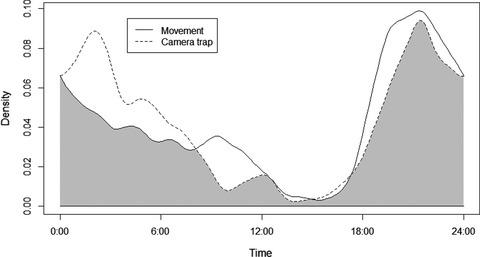当前位置:
X-MOL 学术
›
Remote Sens. Ecol. Conserv.
›
论文详情
Our official English website, www.x-mol.net, welcomes your feedback! (Note: you will need to create a separate account there.)
Are camera traps a reliable method for estimating activity patterns? A case study comparing technologies for estimating brown hyaena activity curves
Remote Sensing in Ecology and Conservation ( IF 5.5 ) Pub Date : 2020-08-01 , DOI: 10.1002/rse2.175 Sarah Edwards 1 , Jenny Noack 1 , Louis Heyns 1 , Diethardt Rodenwoldt 1
Remote Sensing in Ecology and Conservation ( IF 5.5 ) Pub Date : 2020-08-01 , DOI: 10.1002/rse2.175 Sarah Edwards 1 , Jenny Noack 1 , Louis Heyns 1 , Diethardt Rodenwoldt 1
Affiliation

|
Camera traps and radio-tags are both frequently and widely used sampling methods for deriving wildlife activity patterns. While radio-tags continuously monitor a limited number of tagged individuals, camera traps have the potential to monitor all population members, albeit from spatially restricted, fixed points. Such differences might result in differing activity pattern estimates between the two sampling methods. However, few studies have compared the activity patterns derived from simultaneously employed sampling methods, or explored if using combinations of techniques might reveal greater insights into activity patterns. To address this, we compared the activity patterns derived from camera traps placed at latrines and den sites, both in combination and separately, to those from movement rates and the activity sensor collected by GPS collars on brown hyaena Parahyaena brunnea. The activity curve produced by combined camera traps showed a relatively high level of overlap with those produced by the movement rates and activity sensor; 0.88 (95% CI’s 0.87–0.89) and 0.85 (95% CI’s 0.83–0.86) respectively. However, camera traps reflected higher levels of activity from 00:00 to 06:00, than the radio-tag methods, with data from den sites alone producing this higher level of activity. The results suggest that although hyaenas were active during the 00:00 to 06:00 period, they were so mainly at small, localized den sites, which reflected as lower levels of activity as derived by movement rates and activity sensors. Although our results reflect data from a single species and season, they illustrate the value of using a combination of techniques to disentangle complex behavioural activity patterns.
中文翻译:

相机陷阱是估计活动模式的可靠方法吗?比较用于估计褐鬣狗活动曲线的技术的案例研究
相机陷阱和无线电标签都是用于推导野生动物活动模式的常用和广泛使用的采样方法。虽然无线电标签持续监控有限数量的标记个体,但相机陷阱有可能监控所有人口成员,尽管是从空间受限的固定点。这种差异可能会导致两种抽样方法之间的活动模式估计不同。然而,很少有研究比较从同时采用的采样方法得出的活动模式,或探讨使用技术组合是否可以更深入地了解活动模式。为了解决这个问题,我们比较了组合和单独放置在厕所和窝点的相机陷阱得出的活动模式,布氏副鬣狗. 组合相机陷阱产生的活动曲线与运动速率和活动传感器产生的活动曲线显示出相对较高的重叠水平;0.88 (95% CI 的 0.87–0.89) 和 0.85 (95% CI 的 0.83–0.86)。然而,与无线电标签方法相比,相机陷阱反映了从 00:00 到 06:00 的更高水平的活动,仅来自巢穴的数据就产生了这种更高水平的活动。结果表明,虽然鬣狗在 00:00 至 06:00 期间活跃,但它们主要集中在小的、局部的巢穴,这反映了由运动速率和活动传感器得出的较低的活动水平。尽管我们的结果反映了来自单一物种和季节的数据,但它们说明了使用技术组合来解开复杂行为活动模式的价值。
更新日期:2020-08-01
中文翻译:

相机陷阱是估计活动模式的可靠方法吗?比较用于估计褐鬣狗活动曲线的技术的案例研究
相机陷阱和无线电标签都是用于推导野生动物活动模式的常用和广泛使用的采样方法。虽然无线电标签持续监控有限数量的标记个体,但相机陷阱有可能监控所有人口成员,尽管是从空间受限的固定点。这种差异可能会导致两种抽样方法之间的活动模式估计不同。然而,很少有研究比较从同时采用的采样方法得出的活动模式,或探讨使用技术组合是否可以更深入地了解活动模式。为了解决这个问题,我们比较了组合和单独放置在厕所和窝点的相机陷阱得出的活动模式,布氏副鬣狗. 组合相机陷阱产生的活动曲线与运动速率和活动传感器产生的活动曲线显示出相对较高的重叠水平;0.88 (95% CI 的 0.87–0.89) 和 0.85 (95% CI 的 0.83–0.86)。然而,与无线电标签方法相比,相机陷阱反映了从 00:00 到 06:00 的更高水平的活动,仅来自巢穴的数据就产生了这种更高水平的活动。结果表明,虽然鬣狗在 00:00 至 06:00 期间活跃,但它们主要集中在小的、局部的巢穴,这反映了由运动速率和活动传感器得出的较低的活动水平。尽管我们的结果反映了来自单一物种和季节的数据,但它们说明了使用技术组合来解开复杂行为活动模式的价值。


























 京公网安备 11010802027423号
京公网安备 11010802027423号